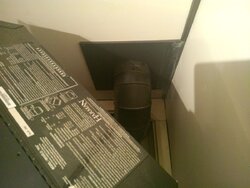When my Harman was installed, an OAK not installed as I was told I did not need one. Last night I discovered where my stove is pulling air from: outside! Attached is a pic of where my stove is vented thru the wall. They had to trim the right side of the wall plate (the black square the vent passes thru) to fit up against the corner wall trim. I found last night that cold air was rushing through the gap between the plate and the trim! The last few days my stove has been set at room temp 70 And the stove had been maintaining this.
Last night I put a piece of cold weather tape over the gap. My fire was not as active - although I would not call it lazy - and my actual room temps were 66 and 67 this morning even tho the stove was still set for 70. (Granted, it was 20 degrees out Last night, but still...)
I took the tape off turned up the room temp and the stove is now merrily working with a tall wall of flame and working to heat up the house.
I had questioned Harman about the need for an OAK thru an email and was told "The only time outside air is needed, is if your home is extremely airtight which would create negative air pressure inside the home. in this case the stove would not operate properly. You would be seeing soot build up inside firebox and would have a very lazy flame, and in most cases the stove would shutdown. If any of the above mentioned issues are occurring, I would recommend having your dealer install an outside air kit."
None of these issues have happened. But not sure that the only reason is because of the cold air around the plate!
Now - do I need to demand installation of an OAK this summer?
Last night I put a piece of cold weather tape over the gap. My fire was not as active - although I would not call it lazy - and my actual room temps were 66 and 67 this morning even tho the stove was still set for 70. (Granted, it was 20 degrees out Last night, but still...)
I took the tape off turned up the room temp and the stove is now merrily working with a tall wall of flame and working to heat up the house.
I had questioned Harman about the need for an OAK thru an email and was told "The only time outside air is needed, is if your home is extremely airtight which would create negative air pressure inside the home. in this case the stove would not operate properly. You would be seeing soot build up inside firebox and would have a very lazy flame, and in most cases the stove would shutdown. If any of the above mentioned issues are occurring, I would recommend having your dealer install an outside air kit."
None of these issues have happened. But not sure that the only reason is because of the cold air around the plate!
Now - do I need to demand installation of an OAK this summer?



 . I have it stuck to the top middle of the front decorative door. Believe it or not, as long as I keep it in the same spot all of the time, the temp readings from it are pretty consistent, so when I saw an increase after the OAK was installed, I had to believe it to a certain degree.
. I have it stuck to the top middle of the front decorative door. Believe it or not, as long as I keep it in the same spot all of the time, the temp readings from it are pretty consistent, so when I saw an increase after the OAK was installed, I had to believe it to a certain degree.

